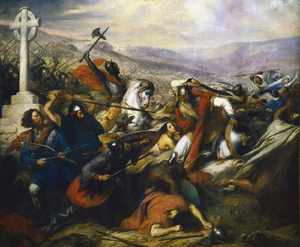
Back الفتح الإسلامي للغال Arabic فتح الغال ARZ উমাইয়াদের গল আক্রমণ Bengali/Bangla Invasió musulmana de la Gàl·lia Catalan Fränkisch-arabischer Konflikt German Invasión musulmana de la Galia Spanish تهاجم امویان به گل Persian Invasion omeyyade en France French Invasi Umayyah di Galia ID ウマイヤ朝のガリア侵攻 Japanese
You can help expand this article with text translated from the corresponding article in Arabic. (January 2024) Click [show] for important translation instructions.
|
This article includes a list of general references, but it lacks sufficient corresponding inline citations. (May 2018) |
| Umayyad invasion of Gaul | |||||||||
|---|---|---|---|---|---|---|---|---|---|
| Part of early Muslim conquests and the Reconquista | |||||||||
 1837 painting by Charles de Steuben of the Battle of Tours (732), depicting a triumphant Charles Martel (mounted) facing Abd al-Rahman al-Ghafiqi (right). | |||||||||
| |||||||||
| Belligerents | |||||||||
|
Francia Aquitaine Gascony Lombard Kingdom | |||||||||
| Commanders and leaders | |||||||||
|
Al-Samh ibn Malik al-Khawlani † Abd al-Rahman al-Ghafiqi † Yusuf ibn Abd al-Rahman al-Fihri | |||||||||
The Umayyad invasion of Gaul occurred in two phases, in 719 and 732 AD. Although the Umayyads secured control of Septimania, their incursions beyond this into the Loire and Rhône valleys failed. By 759 Muslim forces had lost Septimania to the Christian Frankish Empire and retreated to Iberia.
The 719 Umayyad invasion of Gaul was the continuation of their conquest of the Visigothic Kingdom of Hispania into the region of Septimania, the last unconquered province of the Visigothic Kingdom.[1] After the fall of Narbonne, the capital of the Visigothic rump state, in 720, Umayyad armies composed of Arabs and Berbers turned north against Aquitaine. Their advance was stopped at the Battle of Toulouse in 721, but they sporadically raided southern Gaul as far as Avignon, Lyon and Autun.[1]
A major Umayyad raid directed at Tours was defeated in the Battle of Tours in 732. After 732, the Franks asserted their authority in Aquitaine and Burgundy, but only in 759 did they manage to take the Mediterranean region of Septimania, due to Muslim neglect and local Gothic disaffection.[1]
A later Muslim incursion into Gaul, in the ninth century, resulted in the establishment of Fraxinetum, a fortress in Provence that lasted for nearly a century.
- ^ a b c Watson 2003, p. 1.
© MMXXIII Rich X Search. We shall prevail. All rights reserved. Rich X Search